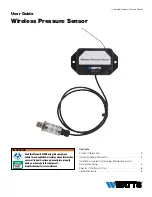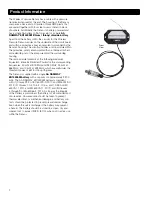
3
Important Safety Information
WARNING
!
The Wireless Pressure Sensor
MUST USE
and
MUST ONLY
use a single
AA RAMWAY ER14505M lithium / thionyl chloride
battery
. The Sensor has ONLY been certified for use with a single AA RAMWAY ER14505M battery . Use of ANY other battery,
or modification of the Sensor to use multiple batteries, and other power source(s) MAY result in sparking and thermal events
that could lead to ignition and explosion in the environments for which the Wireless Pressure Sensor has been otherwise
designed to be deployed . Furthermore, use of a single AA RAMWAY ER14505M battery that has been thermally, electrically, or
mechanically compromised may also lead to ignition and explosions . As discussed below, the single AA RAMWAY ER14505M
lithium / thionyl chloride battery
MUST ONLY be inserted in and removed
from the battery coffin of the Wireless Pressure
Sensor
outside of any hazardous location
and in an area free of potentially explosive dust or gases .
DO NOT attempt to recharge the RAMWAY ER14505M battery . DO NOT incinerate the battery, place it near heating equipment,
expose it to direct sunlight for long periods, or subject the RAMWAY ER14505M battery to temperatures in excess of 343°K
(70°C) . DO NOT short circuit the RAMWAY ER14505M . DO NOT drop, crush, or puncture the battery . DO NOT immerse
the battery in liquids . DO NOT install the RAMWAY ER14505M battery with an incorrect polarity . The battery coffin of the
Wireless Pressure Sensor has a raised plus sign and a raised negative sign to indicate correct polarity .
The pressure transducer and cable of the Wireless Pressure Sensor MUST NOT be deployed in any location where voltage
and current may be injected on any exposed wires arising from accidental melting of insulation, severing, cutting, or cap
removal of the antenna .
The housing of the Wireless Pressure Sensor must be maintained within an ambient process temperature between 253°K to 313°K
(-20°C to 40°C) .
The pressure transducer at the end of the cable may be exposed to process temperatures ranging from 253°K to 343°K
(-20°C to 70°C), as long as the housing is kept within an ambient temperature between 253°K to 313°K (-20°C to 40°C) .
The pressure transducer MUST NOT be exposed to process temperatures above 343°K (70°C) .


























